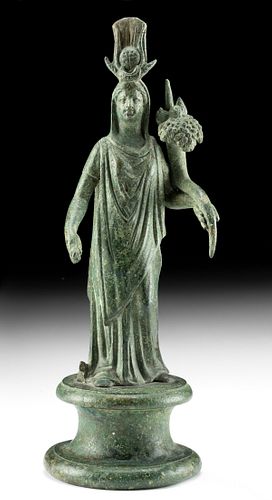Exhibited Romano-Egyptian Bronze Isis-Fortuna
Lot 14
About Seller
Artemis Fine Arts
686 S Taylor Ave, Ste 106
Louisville, CO 80027
United States
Selling antiquities, ancient and ethnographic art online since 1993, Artemis Gallery specializes in Classical Antiquities (Egyptian, Greek, Roman, Near Eastern), Asian, Pre-Columbian, African / Tribal / Oceanographic art. Our extensive inventory includes pottery, stone, metal, wood, glass and textil...Read more
Estimate:
$16,000 - $24,000
Absentee vs Live bid
Two ways to bid:
- Leave a max absentee bid and the platform will bid on your behalf up to your maximum bid during the live auction.
- Bid live during the auction and your bids will be submitted real-time to the auctioneer.
Bid Increments
| Price | Bid Increment |
|---|---|
| $0 | $25 |
| $300 | $50 |
| $1,000 | $100 |
| $2,000 | $250 |
| $5,000 | $500 |
| $10,000 | $1,000 |
| $20,000 | $2,500 |
| $50,000 | $5,000 |
| $100,000 | $10,000 |
| $200,000 | $20,000 |
About Auction
By Artemis Fine Arts
Oct 8, 2020
Set Reminder
2020-10-08 10:00:00
2020-10-08 10:00:00
America/New_York
Bidsquare
Bidsquare : Exceptional Antiquities, Asian, Ethnographic
https://www.bidsquare.com/auctions/artemis-gallery/exceptional-antiquities-asian-ethnographic-5796
Museum-worthy examples of Egyptian, Greek, Roman, Etruscan, Near Eastern, Far East / Asian, Pre-Columbian, African / Tribal,Oceanic, Native American, Spanish Colonial, Russian, Fossils, Ancient Jewelry, Fine Art, so much more! Artemis Fine Arts info@artemisgallery.com
Museum-worthy examples of Egyptian, Greek, Roman, Etruscan, Near Eastern, Far East / Asian, Pre-Columbian, African / Tribal,Oceanic, Native American, Spanish Colonial, Russian, Fossils, Ancient Jewelry, Fine Art, so much more! Artemis Fine Arts info@artemisgallery.com
- Lot Description
Egypt, Romano-Egyptian, ca. 2nd century CE. A stunning cast bronze deity with attributes of two primary goddesses of the Hellenistic world, Isis and Fortuna (Greek Tyche). The goddess dons an elaborate composite headdress referred to as the basileion - the form a sun-disk-crescent with horns and plumes - atop her youthful visage. Her elegant body is dressed in a long flowing chiton and voluminous himation presenting abundant folds of drapery, and the figure stands in contrapposto with her weight shifted and her left leg bent at the knee. Her right arm, extended a tad from her body presents a hand that appears to be gripping something - perhaps Fortuna's rudder, an instrument she used to direct lives. In her left arm, she holds a copious cornucopia or horn of plenty. A lovely statue fo Isis-Fortuna who stands proudly upon a spool-shaped pedestal. Size: 2.75" W x 7.875" H (7 cm x 20 cm)
Although Isis was an Egyptian deity, her popularity spread into the Mediterranean basin from the Ptolemaic period on, prior to becoming embraced by the Romans. In the Greco-Roman world, Isis embodied all things feminine, a beautiful blend of features belonging to Artemis, Aphrodite, and Demeter - a composite goddess who reigned over the sea and the world of the deceased and was also the protector of the city of Alexandria. Due to Isis' power over fate, she was linked with Fortuna (Greek Tyche), the classical goddess of good fortune. Throughout time, humanity has put forth immense efforts toward bringing about good fortune. History has provided many manifestations of this in the form of good luck charms. Even in the modern era, people carry rabbits' feet, blow on dice before tossing them, or wear a "lucky" color shirt to a job interview. The classical era was no different, and the goddess Fortuna/Tyche stood as a symbol of luck and chance for many ancient Greeks and Romans. Initially, she was viewed as a protector of ancient cities and civilizations; however, later Fortuna/Tyche evolved to become a guiding light, a symbol of Lady Luck, for individuals.
Published: J. Eisenberg, The Age of Cleopatra (1988), no. 78.
On loan to Picker Art Gallery, Colgate University; Fitchburg Art Museum, 1990 to 2016.
Cf: Lexicon Iconographicum Mythologiae Classicae (LIMC), vol. V, Zurich, 1997, s.v. Isis, pp. 784 ss and Lexicon Iconographicum Mythologiae Classicae (LIMC), vol. VIII, Zurich, 1997, s.v. Tyche et Tyche/Fortuna, pp. 115-141.
Provenance: private R.K collection, Tecumseh, Michigan, USA collection; acquired from Royal Athena in June 1989
All items legal to buy/sell under U.S. Statute covering cultural patrimony Code 2600, CHAPTER 14, and are guaranteed to be as described or your money back.
A Certificate of Authenticity will accompany all winning bids.
We ship worldwide and handle all shipping in-house for your convenience.
#158236Losses to end of rudder in goddess' right hand and drapery folds by her right leg. Minute fissure and nicks to lower periphery of pedestal. Encrustation on interior of pedestal. Otherwise, generally excellent with fabulous details and rich green patina.Condition
- Shipping Info
-
All shipping is handled in-house for your convenience. Your invoice from Artemis Gallery will include shipping calculation instructions. If in doubt, please inquire BEFORE bidding for estimated shipping costs for individual items.
-
- Buyer's Premium



 EUR
EUR CAD
CAD AUD
AUD GBP
GBP MXN
MXN HKD
HKD CNY
CNY MYR
MYR SEK
SEK SGD
SGD CHF
CHF THB
THB















